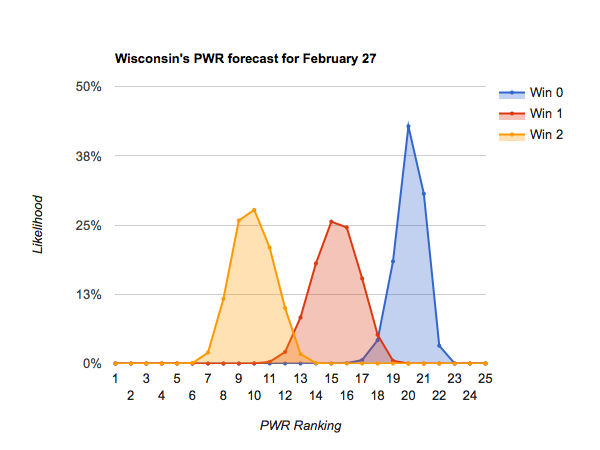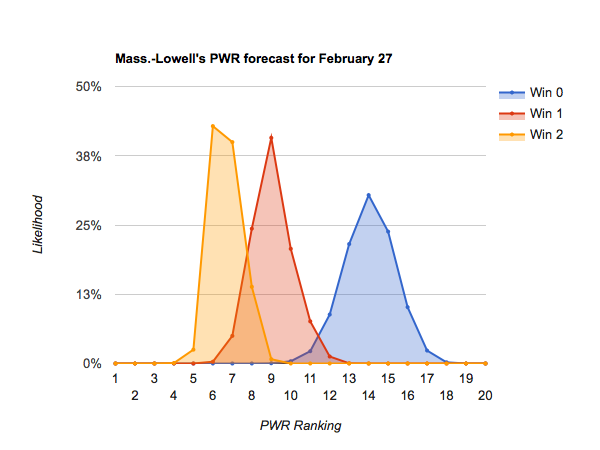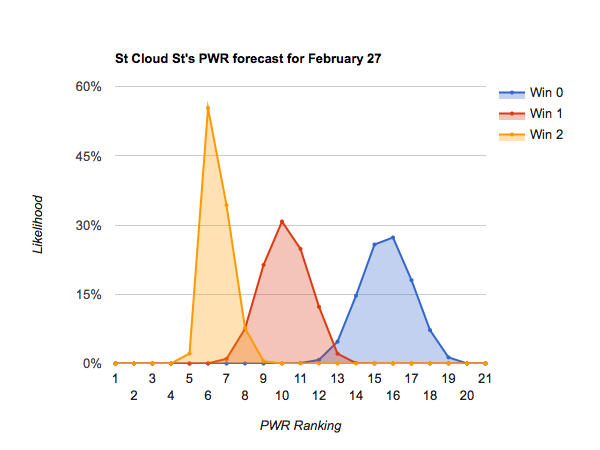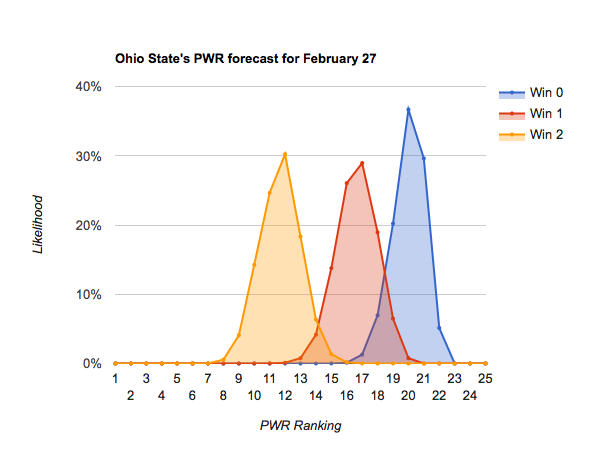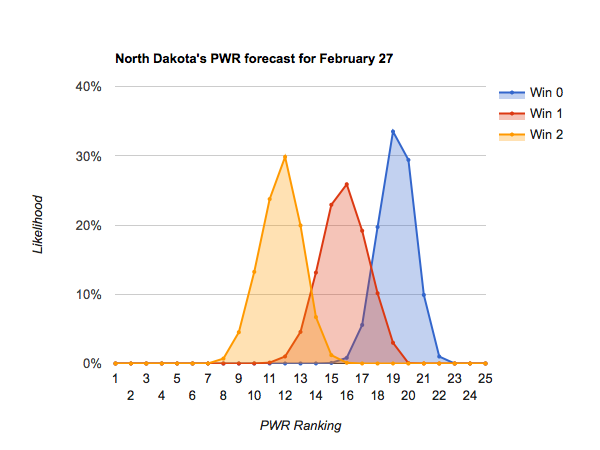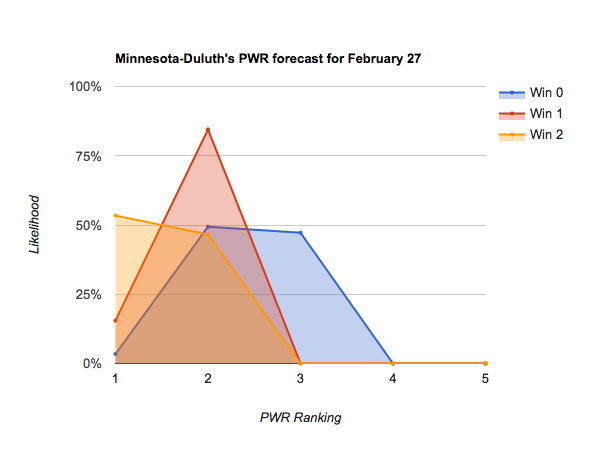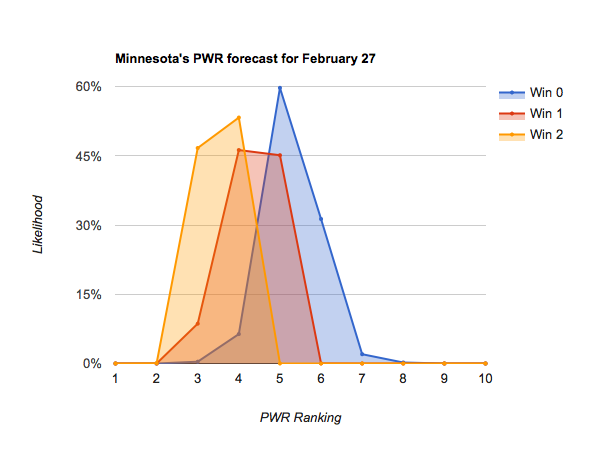In previous columns this week I presented what tournament selection outcomes are most likely, every possible tournament selection outcome, and what determines the fate of teams with the most uncertainty as to outcome. Today, I’ll dive into the nooks and crannies of the most unlikely outcomes to explain how they could come about.
How Union could climb to #2 and Boston College could fall to #3
The key to swapping #2 Boston College (idle) and #3 Union is for Union to overcome BC’s current RPI advantage. That would change the comparison, currently 2-0 in BC’s favor, to 1-1 with the RPI tie-breaker going to Union. Though the current RPI gap is only .5892 for BC to .5810 for Union, it’s difficult for Union to overcome because BC isn’t playing so can’t move down much.
Obviously, the best thing Union can do to improve its own RPI is win two games. To further maximize the benefit, Union prefers to play #6 in RPI Quinnipiac over #16 in RPI Colgate (though Colgate’s better opponent win% somewhat offsets Quinnipiac’s better win%, the quality win bonus for defeating Quinnipiac tips the scales).
The next most important thing for Union’s RPI is to further improve its quality win bonus by having teams it has defeated climb in the RPI ranks. New Hampshire is the most obvious candidate, capable of climbing from its current #18 in RPI to as high as #12. In addition to the benefit it would receive from two wins, New Hampshire would be helped by losses from teams immediately above it such as #15 Colgate, #16 Cornell, #13 North Dakota, #12 Mankato, and #11 Michigan.
Finally, Union can pick up a few other quality win bonus points by having Bowling Green become a contender.
Here’s an example of one such scenario:
http://goo.gl/qs5CXO
When such factors all come together Union can climb to #2 in about .5% of remaining possible outcomes, or about 2% of the scenarios in which Union wins its conference tournament.
How Providence could miss the NCAA tournament
The two keys to Providence missing the NCAA tournament are for Providence to fall in the PWR and for conference autobids to go to teams that wouldn’t make it at large. Combined, the two can push Providence down and move the line for an at-large bid up enough such that Providence doesn’t make the tournament.
For Providence’s PWR to fall sufficiently, Providence must exit winless by losing its first game. Second, a combination of teams below Providence must rise sufficiently to further push Providence down.
Here’s one such example in which #16 Cornell, #10 St Cloud St, and #14 Vermont pass Providence, pushing it to #12. This scenario additionally features 5 of the 6 conference autobids going to teams below the cutoff, thus denying #12 Providence an at-large bid.
http://goo.gl/uevH6G
Similar factors come together for Providence to miss the NCAA tournament in about 1.3% of remaining outcomes, or about 2.6% of scenarios in which Providence loses its first game.
How St. Cloud State could miss the NCAA tournament
The principles for St. Cloud State missing are the same as for Providence — St. Cloud St’s PWR must fall and conference autobids must go to teams that wouldn’t make it at large.
Because SCSU is idle, it’s a little harder to move their PWR. The biggest lever available to do so is the quality win bonus. St. Cloud St currently enjoys QWB’s from wins over #3 RPI Union, #12 RPI Minnesota State, #13 RPI North Dakota, #16 RPI Colgate, and #19 RPI Western Michigan. Poor performances from those teams, and resulting drops in SCSU’s QWB, are key to St. Cloud St missing.
Here’s one such scenario in which each of the above loses as many as possible, pushing SCSU down to #12. This scenario additionally features 5 of the 6 conference autobids going to teams below the cutoff, thus denying #12 St Cloud St an at-large bid.
http://goo.gl/slBcnQ
Similar factors come together for SCSU to miss the NCAA tournament in only 80 of the 3,145,728 remaining possible scenarios (about .003%).
How North Dakota makes the NCAA tournament without any more wins
A quirk of this year’s revised conference tournaments is that only the NCHC has a consolation game, thus an opportunity for a team to go winless across two conference tournament games.
For North Dakota to make the tournament without any additional wins, the principles are familiar — maximize UND’s PWR ranking while having as many conference autobids as possible go to teams that would otherwise make the tournament at large.
Another quirk of consolation games is that they can end in ties. To maximize UND’s PWR without a win, North Dakota needs a loss in the opening game but a tie in the consolation game. Even with a loss and a tie, UND’s PWR is almost certain to fall, so the key is for teams around UND to perform poorly enough that UND’s fall is minimal.
There are a few ways that could happen, but here’s one such scenario in which only two teams (#18 Northeastern and #14 Vermont) rise above UND but only one (#11 Michigan) falls below, resulting in a net loss of only one position to #14. This is dependent on poor performance by #15 Colgate, #16 Cornell, and #17 New Hampshire. This scenario additionally features only two conference tournaments going to non-autobid teams, thus allowing #14 UND to get an at-large bid despite no additional wins.
http://goo.gl/HS0PSQ
Similar factors come together for UND to make the NCAA tournament in about .5% of outcomes in which UND loses the first game, or about 1.5% of outcomes in which UND loses the first game then ties the consolation game.
How Colgate makes the NCAA tournament without any more wins
The principles for Colgate making the NCAA tournament without another win are similar to those for North Dakota — maximize Colgate’s PWR and have as many conference autobids as possible go to teams that would otherwise make the tournament at large.
Because we’ve already stipulated that Colgate must lose a game, maximizing its PWR relies primarily on poor performance from the teams around it and an improvement in its quality win bonus.
There are a few ways to do that, but here’s one such scenario in which #15 Colgate passes two teams (#12 Mankato and #13 North Dakota) while being passed by only one (#17 Northeastern) resulting in a rise to #14. While this is dependent on poor performances by North Dakota and Northeastern, it is also helped by a poor performance from Cornell and a mixed performance from New Hampshire to prevent those teams from overtaking Colgate. Colgate’s PWR is also helped in this scenario by a modest rise in its quality win bonus from good performances by Ferris State, Quinnipiac, and Union. This scenario additionally features only two conference tournaments going to non-autobid teams, thus allowing #14 Colgate to get an at-large bid despite no additional wins.
http://goo.gl/WjT4bM
Similar factors come together for Colgate to make the NCAA tournament in about 2.1% of scenarios in which it loses its lone conference tournament game.
How Cornell makes the NCAA tournament without any more wins
The principles for Cornell making the NCAA tournament without winning are the same as for North Dakota and Colgate — maximize Cornell’s PWR and have as many conference autobids as possible go to teams that would otherwise make the tournament at large.
Because we’ve already stipulated that Cornell must lose a game, maximizing its PWR relies primarily on poor performance from the teams around it and an improvement in its quality win bonus.
Though #16 Cornell has a slight RPI edge on #15 Colgate (Cornell is currently one PWR rank lower because it loses the comparison between the two because of their H2H results), it has a much tougher time improving its PWR this weekend because it doesn’t have the wins versus Ferris State and Union that give Colgate the opportunity to improve its quality win bonus. While wins by Quinnipiac help a bit, Cornell’s RPI seems doomed to fall.
So, to actually rise in the PWR (#16 won’t make it at large because the AHA autobid will go to someone not in the top 16), Cornell needs more teams above it to fall than teams below it rise. Here’s a scenario in which only one team (#15 Colgate) dips below Cornell while no teams below Cornell rise, resulting in Cornell taking the #15 spot. To make the tournament from #15, this scenario also features only one team outside the top 15 winning its conference tournament.
http://goo.gl/GJlLTr
Such a set of outcomes useful to Cornell is quite unusual, occurring in only 182 of the 1,572,864 scenarios in which Cornell loses its lone game (about .01%).
